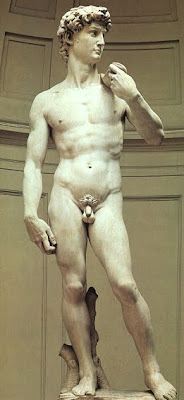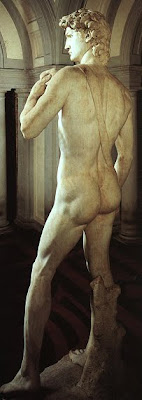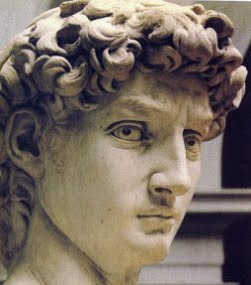 El David, consulted on Saturday October 3rd, 2009. Available at: https://blogger.googleusercontent.com/img/b/R29vZ2xl/AVvXsEhaj6g7-OihwqcUIsI5srRzdoNx4HvjBN4yyNYyhQrJyWVXeZaQw-k_7JQs5IwEpn1N7FyfrcOnXpFLjLurWhTbXHdZHz9oSSJHJmZSEhhflgW3hgsTNDoqi1BbbpmJnbAniNMIAA5dXK8/s1600-h/david.jpg
El David, consulted on Saturday October 3rd, 2009. Available at: https://blogger.googleusercontent.com/img/b/R29vZ2xl/AVvXsEhaj6g7-OihwqcUIsI5srRzdoNx4HvjBN4yyNYyhQrJyWVXeZaQw-k_7JQs5IwEpn1N7FyfrcOnXpFLjLurWhTbXHdZHz9oSSJHJmZSEhhflgW3hgsTNDoqi1BbbpmJnbAniNMIAA5dXK8/s1600-h/david.jpg El David, consulted on Saturday October 3rd, 2009. Available at:
El David, consulted on Saturday October 3rd, 2009. Available at:https://blogger.googleusercontent.com/img/b/R29vZ2xl/AVvXsEg6z4OlacOTRqIwCrpVLcVVPr0xBjM043KQGaswpZY5vcEiwGHFshMkNGKQ8BV3bkzrRWIW1bW6GHXPMdQRQjgZqS7wrGrzov7o9PckPr9n-6WBNfJEKznPAm-xRyiyJRrR5j7Sj4pymBw/s1600-h/david_r1.jpg
Classification...
1. Name of the work: “El David”.
2. Name of the author: Michelangelo Buonarroti (1475 – 1564).
3. Period: 1501 – 1504.
4. Place where the work is at: Academy Gallery in Florence (Italy). Until 1947 the sculpture was located in the Piazza della Signoria in the same city (In where now we can seen a copy).
5. Technique: “ex uno lapide” (a single piece of carved marble without more stones). Italian Renaissance.
Analysis...
1. Material: Marble.
2. Movement: Rigid.
3. Type: High relief.
4. Posture: standing with one knee bent and also one arm.
5. Body part: Whole body (Are clearly visible facial features, curly hair and muscle).
6. Relationship with architecture: High relief, inside a building.
7. Theme: Nudity and historic (Michelangelo's David represents a large size of this biblical king classic style: stark naked, and as an athlete, carrying in his left a deep (resting on his shoulder), and in the right, a stone).
8. Principles: Proportion, symmetrical balance, complete perfection of man.
Specific characteristics of the work...
1. What is so special and unique about this work of art?
Michelangelo's David represents the king as an athlete, as a man in the prime of his life. He chose as the reason for the work, the time before David's confrontation with the giant Goliath (whose head is not defeated at his feet, as usual in other representations). Therefore, the content and expectant look that shows us the figure, with the typical features of a fighter who is preparing to battle. This expectation is reflected in his eyes, extremely sharp, and is also expressed through bodily tension: the musculature (and even tendons and veins) are clearly visible. We can clearly speak of a movement content, which becomes pure body tension (Juan Diego Caballero).
 Caballero, Juan Diego. “El David de Miguel Ángel”. ENSEÑ-ARTE. February 22nd, 2006, available at:
Caballero, Juan Diego. “El David de Miguel Ángel”. ENSEÑ-ARTE. February 22nd, 2006, available at:<http://aprendersociales.blogspot.com/2007/02/el-david-de-miguel-ngel.html>
 Caballero, Juan Diego. “El David de Miguel Ángel”. ENSEÑ-ARTE. February 22nd, 2006, available at:
Caballero, Juan Diego. “El David de Miguel Ángel”. ENSEÑ-ARTE. February 22nd, 2006, available at:<http://aprendersociales.blogspot.com/2007/02/el-david-de-miguel-ngel.html>
Michelangelo used the contrapposto and increases the volumes of certain body parts, which come to symbolize the strength (not only or mainly physical) of King David. “Such traits are clearly visible in the size of the head (the fee is 1 / 8 of the body) and the power and size of the right hand holding the stone, the king weapon used to defeat Goliath. This leads to the concept of “terribilita” that characterizes other works” (Juan Diego Caballero).
All these traits make the sculptural figure of King David, a symbol of freedom, representing the ideal perfection of Renaissance male beauty (Juan Diego Cabllero)...
Relevant events of the context...
The David was commissioned to Michelangelo originally by the canons of the cathedral of Florence (place where the block of marble was carved), but once completed it, and in view of the result, the guild of wool merchants of the city, decided to buy it to put it opposite the Palace of the Signoria... “So that serve as a clear representation of freedom of the Florentine republic. In this sense, the sculpture is a true reflection of the mentality that exists in Florence, a city in which the approaches of the bourgeoisie engaged in commerce and banking were widely extended” (Juan Diego Caballero).
“Michelangelo completed the development of this sculpture in 1504, when he was 29 years old. Some years earlier he had already done the Pieta in the Vatican, in which “terribilita” traits are not yet detectable. In this sense, David precedes the completion of the work of the tomb of Pope Julius II and, especially, to the sculpture of Moses, in which such traits are still outstanding” (Juan Diego Caballero).
Reflection: Relationship between the context and the work...
The Renaissance was a cultural expression of Humanism originated in Italy, in where changes were philosophical, artistic and literary... So, the David is an excellent piece of art that demonstrates confidence in man, in his reason and his ability to cultivate the branches of wisdom, so this sculpture is part of the Italian Renaissance.
“El David” marked the beginning of the great statues of the Cinquecento... It reflects the human virtues, and from where you try to express the humanistic ideas that reach the artist. It shows the human body and athletic youth.
Personal Reflection...
“El David” marked the beginning of the great statues of the Cinquecento... It reflects the human virtues, and from where you try to express the humanistic ideas that reach the artist. It shows the human body and athletic youth.
Personal Reflection...
This sculpture is sensational ... It demonstrates the complete perfection of a man (both: internal and external).
I think that Michelangelo had a sense of well-developed sight... Because I have always believed that through the eye, the artist captures the values that want to reflect, and then, study his brain ...and with his hand makes it true (designs, runs). So he had that gift.
Because by the eye is captured the inner beauty, the truth...
If we look closely at the detailed features of the face (the profile of the nose, the eyebrows, the iris, the eyelids...) we can capture somehow the expression, the feeling. If we focus on the anatomy of the body (the chest, the abdomen, the veins of the hands, the feet, the nails, the knees) shows clearly a tension concentrated, as occurs somewhat calm and balanced figure.
It is therefore in facial expression, body twist and right hand are where the tension is concentrated (although at no time shows that the stone comes out of the sling, or see the stone= as legend).
It is curious that the sculpture turns his face to the left (because by that time this represented the evil side or the dark side), and thus would be located Goliath...
I think that Michelangelo had a sense of well-developed sight... Because I have always believed that through the eye, the artist captures the values that want to reflect, and then, study his brain ...and with his hand makes it true (designs, runs). So he had that gift.
Because by the eye is captured the inner beauty, the truth...
If we look closely at the detailed features of the face (the profile of the nose, the eyebrows, the iris, the eyelids...) we can capture somehow the expression, the feeling. If we focus on the anatomy of the body (the chest, the abdomen, the veins of the hands, the feet, the nails, the knees) shows clearly a tension concentrated, as occurs somewhat calm and balanced figure.
It is therefore in facial expression, body twist and right hand are where the tension is concentrated (although at no time shows that the stone comes out of the sling, or see the stone= as legend).
It is curious that the sculpture turns his face to the left (because by that time this represented the evil side or the dark side), and thus would be located Goliath...
Geographic location of the place of origen of the work...
 Mapa de Florencia, Italia, consulted on Saturday October 3rd, 2009. Available at:
Mapa de Florencia, Italia, consulted on Saturday October 3rd, 2009. Available at:<http://www.e-global.es/viaje-turismo-online/wp-includes/graficos/florencia_mapa.jpg>

Mapa Europeo, consulted on Saturday October 3rd, 2009. Available at: <http://gif1.luventicus.org/mapas/europa/italia/florencia.gif>
Bibliography
1. Caballero, Juan Diego. “El David de Miguel Ángel”. ENSEÑ-ARTE. February 22nd, 2006, available at:
<http://aprendersociales.blogspot.com/2007/02/el-david-de-miguel-ngel.html>
2. Mapa de Florencia, Italia, consulted on Saturday October 3rd, 2009. Available at:
<http://www.e-global.es/viaje-turismo-online/wp-includes/graficos/florencia_mapa.jpg>
3. Mapa Europeo, consulted on Saturday October 3rd, 2009. Available at: <http://gif1.luventicus.org/mapas/europa/italia/florencia.gif>
4. Michelangelo´s Davis, consulted on Saturday October 3rd, 2009. Available at:
<http://vlsi.colorado.edu/~rbloem/david.html>
My own artistic creation based on the original work...
My interpretation tries to create a hall museum in which are the most precious copies of "El David".
There are four pieces produced by different artists:
1. Plaster Sculpture (Author unknown)
2. Watercolor (Sebastian Gatica)
3. Soap Sculpture (Fernanda Covarrubias)
4. Paint colors (Fernanda Covarrubias)
On the sides we can see the shadows of some photographers, indicating the opening of the room.
The four imitations are unrivaled... Seeing them together, a feeling of strength and freedom pervades the interior of bodies.
All were essential to every artist. And if one of they don´t express what is within him/her, he/she can not survive... These activities determine the historical evolution and even the physical transformation of people.
There are four pieces produced by different artists:
1. Plaster Sculpture (Author unknown)
2. Watercolor (Sebastian Gatica)
3. Soap Sculpture (Fernanda Covarrubias)
4. Paint colors (Fernanda Covarrubias)
On the sides we can see the shadows of some photographers, indicating the opening of the room.
The four imitations are unrivaled... Seeing them together, a feeling of strength and freedom pervades the interior of bodies.
All were essential to every artist. And if one of they don´t express what is within him/her, he/she can not survive... These activities determine the historical evolution and even the physical transformation of people.

